The Russian Blue cat is one of the most charming and mysterious cat breeds in the world. Its characteristic silvery-blue fur immediately catches the eye of any observer. But this beauty is not the only reason to get to know this unique breed of cats better.
Russian Blue Cat — History
The first mentions of the Russian Blue breed come from Scandinavia and the northern regions of Russia. Medieval clothing elements made of blue cat fur found in a Viking museum in Paris indicate that the fur of Russian Blue cats was used as a trade commodity.
Thanks to the lifestyle of the Vikings, this breed also made its way to Spain and Malta (hence its other names: Maltese cat, Spanish Blue). They transported themselves to England as stowaways—arriving with the first shipments following the signing of Anglo-Russian trade agreements in the mid-16th century (thus another name—Archangel cat).
The cats that found themselves in completely different climatic conditions had to adapt. The thick and dense fur that allowed them to survive extreme temperatures in Russia was no longer necessary and even became a burden in the island climate. The character of Russian cats also evolved—they no longer had to fear hunters who hunted them. A friendly relationship between humans and cats began to form.
Meanwhile, Russia also appreciated the Russian Blue cat. In 1850, at the Tsar’s court, one could drink “Russian Blue Cat” vodka. It is also known that Tsar Nicholas I had a favorite Russian Blue cat to whom he confided the state’s greatest secrets. Apparently, this trend spread quickly, as the breed soon reached noble courts. The Russian Tsar also played a role in promoting the Russian Blue cat— in 1901, he presented a pair of these cats to the English Queen Victoria and her son Edward VII. The prince even became an honorary patron of the association of short-haired Russian cat breeders.
The war turmoil of the 20th century was also very dangerous for the Russian breed of cats—it was at risk of extinction. To prevent this, breeders crossed this natural breed with others, mainly Siamese cats. Despite initial enthusiasm, the experiments were quickly halted, as the body structure of the “hybrids” differed significantly from the original (M. Rockford played an important role in this difficult process).
Pope John Paul II also had two Russian Blue cats in his papal apartments in the Vatican. The first male of this breed came to Poland in 1990. Then three female cats were imported. Since then, Russian Blue cats have successfully settled in domestic breeding and increasingly in homes.
Russian Blue Cats — Breed Descriptions and Standards
The Russian Blue cat, due to its turbulent history, has developed several standards, including color variations and long-haired types. Virtually every feline federation has its standard.
Links to the standards of the most popular federations are provided below:
The main distinction reflecting appearance can be grouped into European and American Russian Blue cats, although these names can be misleading. The types refer to regions of the world/Europe where selective breeding has established the Russian Blue cat with specific traits. Currently, due to the prevalence of imports, Europe has many American Russian Blues and vice versa. Regardless, these two main types and their variations can be distinguished.
In the first group, the European Russian Blue cats (also called the old type), we can point to the English and Swedish types. Both differ slightly.
- The English type Russian Blue cat is known for its heavier build and vertically set ears. The coat color is medium in shade, the coat is thick and soft. The whiskers are visible.
- The Swedish type features smaller ears set more to the side of the head, spaced wider apart. The fur is darker and less delicate, and the eyes have a rounder shape (although still almond-shaped).
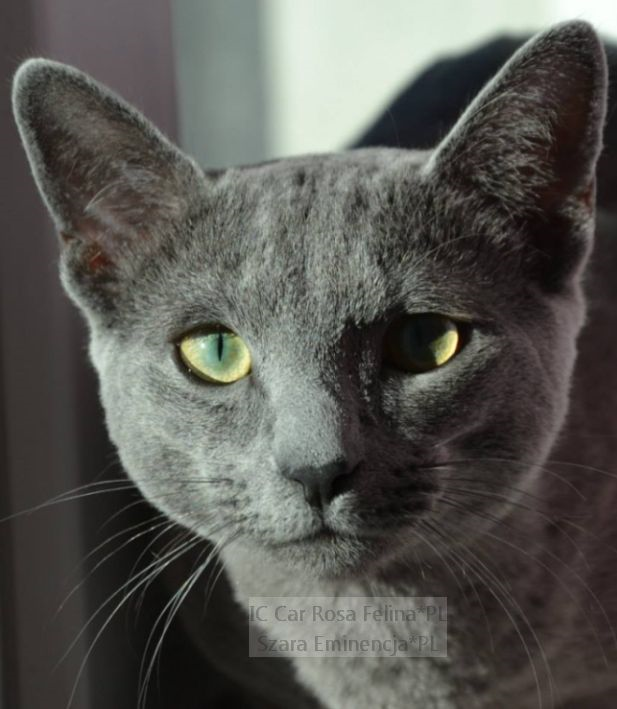
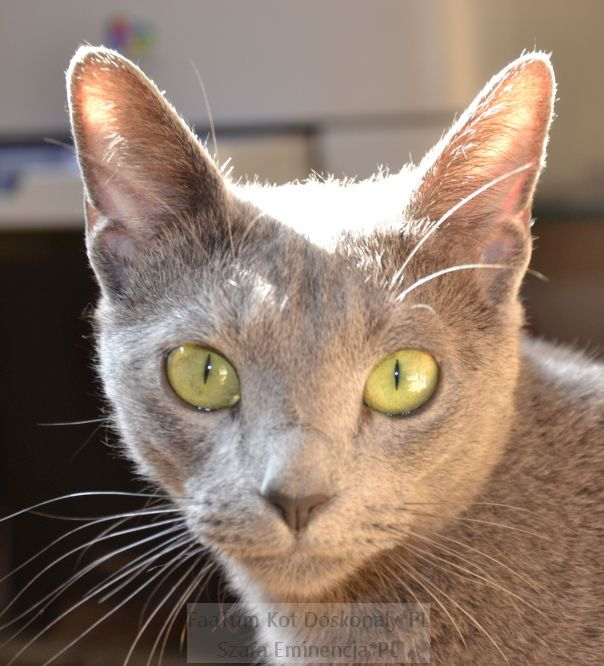
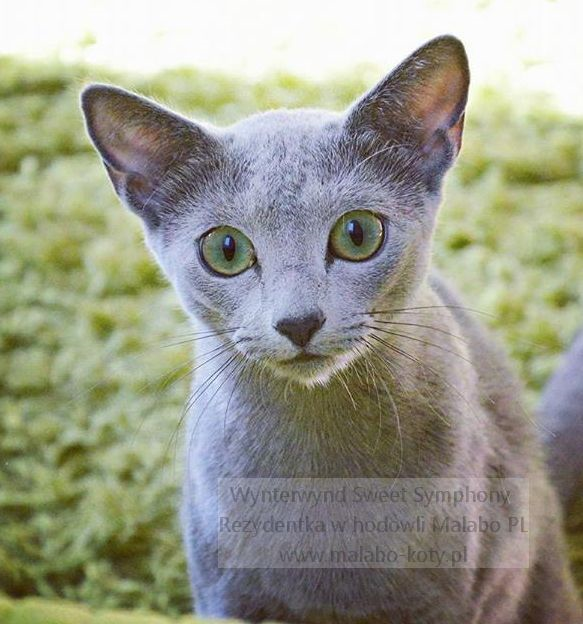
The second group consists of American-type Russian Blue cats, which differ significantly from their European counterparts. Some also distinguish the Japanese type within this group. In fact, Russian Blue cats living in Japan mainly come from North America—due to strict import regulations and the territorial limitation of the island, the cats living there are bred within the available gene pool, which sharpens certain traits (mainly a wider ear spread).
The American Russian Blue is smaller and longer than European cats, with a more delicate build. The coat color is much lighter (silver) and strongly contrasts with the vivid green eyes, which have a round shape. The ears are large, widely set (compared to European ones), and positioned on the head at an angle (a line connecting their tips and further towards the chin should form a triangle). The whiskers are less visible, and the smile is more pronounced. The Japanese type, “twin” to the American type, features wider-set ears and (even) larger round eyes.
Besides these types, it’s worth mentioning the so-called mix—intermediate type between American and European, which is particularly common in our part of Europe. The Russian Blue mix is a cross between these two main types. Since both European and American types can vary, so do the mixes. These are usually Russian Blue cats with a strong build, prominent ears, and a medium blue color—between the American and European types.
Color Variations of Russian Blue Cats
In the 1970s, Australian breeder M. Jones aimed to achieve a colorful variation of the Russian Blue cat by crossing it with a white domestic cat. By the late 1970s, breeding organizations in Australia recognized both white and black colors of this breed. However, most feline organizations still only recognize the blue variety of the Russian Blue shorthair, thus disqualifying other coat colors (including FIFe, of which the Szara Eminencja*PL cattery is a member).
Color variations are particularly popular in Australia, Africa, and North America. The recognized colors of the Russian Blue cat in these regions include: white (with occasional odd-eyed cats), black, and tabby (though this last coloration is not recognized anywhere else in the world).
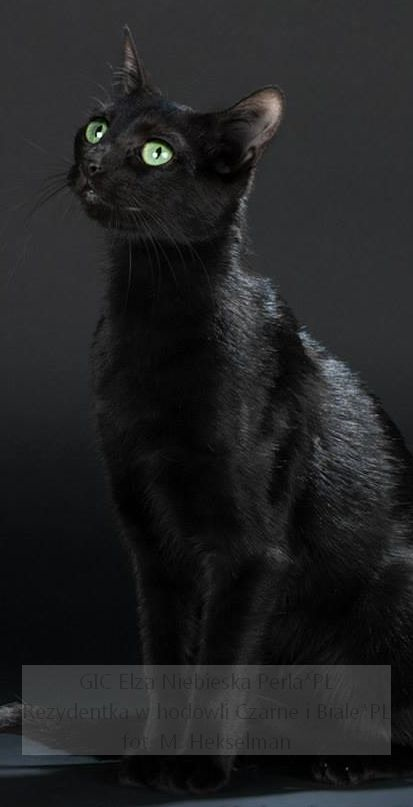
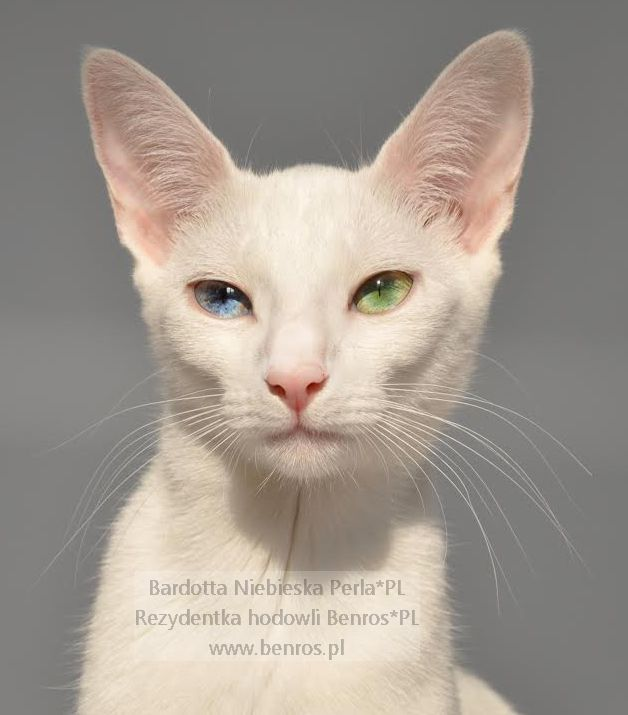
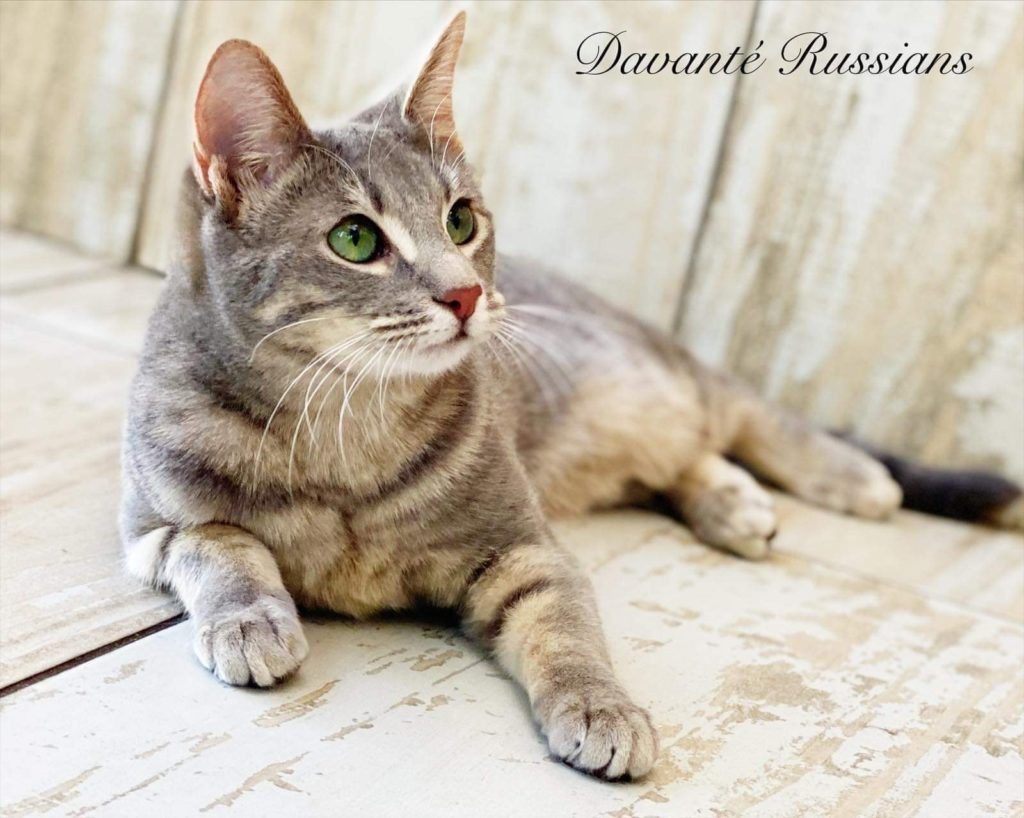
There are also Russian Blue cat breeders in Poland, operating under the auspices of WCF, that have cats in color variations other than blue.
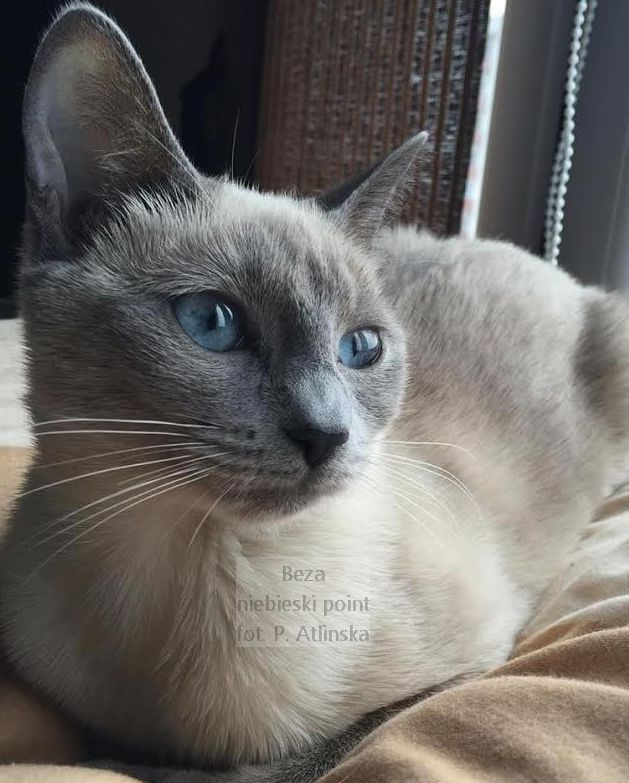
A variation of the Russian Blue cat is the color point version. A legacy of crossing Russian cats with Siamese cats after World War II, this variation inherits the gene responsible for the point pattern—blue color covers the face, lower legs, and tail tip, while the rest of the fur is white/beige; the point’s eyes are azure. Efforts have been underway for some time to legalize these so-called Archangel cats.
Nebelung and the Russian Blue Cat
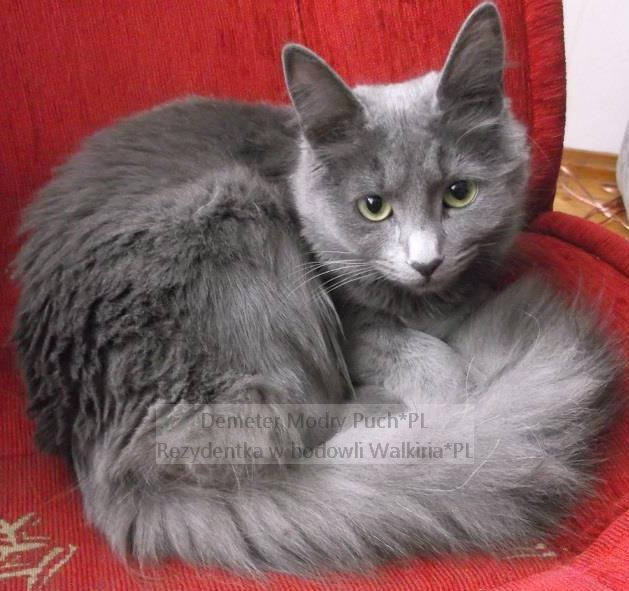
Nebelung is a cat related to the Russian Blue, although secondarily, not primarily—their history is different. The first breeding pair of Nebelungs did not have a “Russian” origin (breeders opposed recognizing them as long-haired Russian cats when registering the breed, which is also due to different breed standards in many federations, such as TICA)! However, due to the permission to cross (outcross) Nebelungs with Russian Blues, the lack of restrictive breeding, especially in the East, revealed (secondary) genetic kinship of the breeds, causing confusion in this regard.
Appearance Features of Russian Blue Cats
- SIZE: The Russian Blue cat is of medium size. It is generally accepted that the weight ranges from 3 kg to 5.5 kg. Females are smaller and more delicate. Males, on the other hand, have a larger and more massive build, often appearing twice the size of a female of the same breed.
- BODY SHAPE: The Russian Blue’s silhouette is slim and graceful. It is complemented by long legs ending in oval feet and a fairly long, proportional tail. They are characterized by a short head, flat skull, and forehead. A straight nose. Large, wide-at-the-base, and erect ears, sharply pointed.
- COAT: Most feline organizations (including FIFe) recognize only the blue variant of the Russian Blue shorthair. The fur color should be uniformly blue-gray with a silver sheen (darker “stripes” are allowed only on the tail tip in adult individuals, while in kittens, they are acceptable). Russian Blue cats have dense, thick, double fur. The undercoat gives it a silky smooth feel. Each hair has a colorless tip, creating the effect of a silvered coat and giving the fur a shine.
- SKIN: The skin of Russian Blue cats is blue—it is best observed on the inner side of the ear (in other places, due to the dense fur, the skin color is very difficult to see). The paw pads are lavender in color.
- EYES: Russian Blues should have large emerald green eyes, almond-shaped.
CHARACTER of Russian Blue Cats
The Russian Blue cat is naturally calm and subtle—noise and shouting bother it. This does not mean it is not playful! Indeed, any time devoted solely to it is rewarded with a great deal of affection. This breed is intelligent—it can successfully learn to walk on a leash, fetch, travel on a person, etc. At the same time, it is a very gentle cat, both towards adult household members and children. It is very sensitive, as D. Sumińska writes, “…we must primarily notice its delicate advances. Not paying attention to it is the first step to feline depression.”1 Excessive affection is not advisable. The delicate psyche of the Russian Blue cat, combined with its submissiveness and gentleness, does not allow it to free itself from intrusive captivity. It is generally a quiet creature, although “talkative” cases do occur.
Diseases of Russian Blue Cats
As one of the few natural breeds not inbred (in relation), Russian Blue cats do not tend to have hereditary diseases (like in Devon Rex cats, for example). However, this does not exempt the caretaker from preventive measures, as they can develop any feline diseases, including infectious ones. D. Sumińska indicates chronic kidney failure as the only “typical” health risk for Russian Blues. Therefore, preventive actions should include a properly balanced diet (especially avoiding a mono-diet) and regular kidney health check-ups using ultrasound.
Caring for a Russian Blue Cat — Needs and Care
The Russian Blue cat is quite easy to care for. Unlike long-haired cats, it does not require extraordinary grooming. Brushing its fur with a coarse comb once a week to remove loose hair or wiping it with a damp cloth is sufficient. Clipping the claws twice a month is also recommended. A well-balanced diet, access to fresh water, a clean litter box, regular check-ups, and vaccinations, along with attention from the owner and a scratching post, make up the complete list of these charming animals’ expectations. This may seem like a little…
Besides appropriate living conditions (complete dry and wet food in appropriate amounts according to age and needs, fresh water, a clean litter box, the right temperature in the room they stay in), and proper vaccinations, the most important requirement is attention, which I would like to emphasize.
This attention is not just from anyone. The cat chooses among the household members the person to whom it directs its feline affection. In our cattery, FaaTum, Jafa, and Car chose me, Astra is my husband’s cat, Amika belongs to my mother, and Diva to my stepfather. Therefore, feeding, cleaning, etc., do not influence the cat’s choice, unlike dogs. For cats, this is standard (it is often said that dogs have friends among people, while cats have servants… there is something to it).
How does feline love manifest? Increased interest, trust, and submission. For example, my husband’s cat, of course, comes to me for affection only when he is not around or when he is busy. Or she comes for a while and then goes back and lies next to him… It is enough for me to wear some of my husband’s clothes to encourage Astra to spend time together. On the other hand, when we are both at home, FaaTum ignores my husband. Several days without me need to pass before she approaches him and allows herself to be petted. This proves the very close and specific relationship that a Russian Blue establishes with a person they are close to.
Due to their character, Russian Blue cats become very attached to their chosen person. Therefore, they do not handle separation well. I do not recommend leaving a Russian Blue alone in the house for more than three days. It is best to provide them with company—ideally, another cat. This is mainly for “psychological” reasons. As I mentioned, this breed has a very delicate psyche. Caring for it means maintaining constant contact (a cat, after three days of the owner’s absence, considers them dead… and experiences trauma). There are, of course, situations where it is impossible to avoid leaving the cats alone. I have experienced such situations too. After returning, the cats complain incessantly, don’t leave my lap for an hour, demand endless affection, and the amount of fur they lose in this short time best proves how stressful it was for them to stay without care.
This does not mean that cats should be deprived of stress altogether! On the contrary. I sometimes “expose” my cats to stress so that they handle stressful situations better in the future (e.g., putting them in harnesses, which they dislike, but they walk around in them for a while). The simplest stressful situations for a cat are, for example, a visit to the vet, a car ride, staying in a new place, or even a visit from a stranger. It is enough for the caretaker to work— the cat experiences daily stress. Over time, of course, they get used to the regular absence, but after returning, they will expect play, affection, and attention with increased intensity. Frequent trips are a worse option. In such cases, it would be good if someone “familiar” (familiar to the cat!) could take care of the cat left alone for more than three days. After a short period of the caretaker’s absence, the cat will get used to it to some extent. However, it is still an experience for them, and one should be aware of it.
Russian Blue cats do not like changes, especially when they come suddenly and unexpectedly—like noise or shouting. These are not appropriate disciplinary methods for a cat. One should not shout at them, as it, firstly, strains the caretaker’s nerves, and secondly, causes frustration in the cat, which may be relieved in the least desired way—for example, by doing their business outside the litter box “out of spite” or responding aggressively to the caretaker’s behavior. In our home, the cats are allowed many things, but not everything. Clapping hands or using a water spray is one of the motivating methods that work on our cats concerning prohibitions and do not harm them.
Russian Blue Cat and Children
I have often encountered the opinion that Russian Blue cats do not like children or, worse, are dangerous to them. This is obviously untrue. The best proof is the interaction of the cats from the Szara Eminencja*PL cattery with my son (the cats have been in the house since Jakub was four months old!). I invite all skeptics to the cattery to see their interactions firsthand.
From my observations, as long as the child is relatively calm and does not harm the animals, there is no problem. The child should, of course, not be allowed to do too much (e.g., pulling the cat’s tail), but the cat should also not be left unpunished—they must know that biting, scratching, and similar behaviors are not allowed.
The cats from my cattery have never behaved aggressively. None of us have ever been scratched or bitten, especially not my son. The cats tend to treat him like their own child—when he cries, they respond quickly by coming to me and meowing as if to say, “do something!”, and when he is sick, they do not leave his side, allowing him more than usual. They rather take care of him. However, when my son goes overboard with “affection” or behaves in a way that one of the cats does not like, they meow (both cats signal their boundaries this way) or walk away (Faa Tum most often, while Astra and Jafa need to be freed—they do not have such developed defense mechanisms).
Children love spending time with our cats, petting them, cuddling them, and playing with them. If I had to describe the ideal profile of a future caretaker, it would be a calm and settled person, quite often at home, preferably daily, rarely traveling, and if so, only for short periods. However, it is best when it is a family, sensibly approaching the upbringing of both children and cats, or a couple. This increases the “pack,” giving the cat more chances for play and attention from close people. This does not exclude adoption by a single person or a family with children, but they must remember the delicate psyche of the Russian Blue. I also know accounts of sick people, including sick children, who greatly value therapies involving Russian Blue cats (felinotherapy), both provided by trained specialists and through adoption and breeding of a kitten.
Everyone Has to Start Somewhere – Practical Tips for Future Cat Owners
A kitten that leaves the cattery, according to the requirements set by the organization we are affiliated with, is at least 14 weeks old, healthy, twice vaccinated, and dewormed. It is accustomed to using a litter box and a scratching post. It receives documents confirming its noble birth, such as pedigree, health book, and possibly other documents, as well as a starter kit to ease its acclimatization in its new home, and a bag of good advice for future reference, along with ongoing support depending on future needs.
Regardless, I present below a series of practical tips for future owners of a small Russian Blue kitten, who decide to adopt a kitten of this breed not only from our cattery.
Theoretical and Practical Preparation
Before making the decision to adopt, I recommend thorough preparation, which includes getting to know the breed in general. I suggest reading descriptions of the breed, their specific traits, requirements, needs, and care, to avoid unnecessary disappointments. A Russian Blue will never have the size of a dog or the long fur of a Maine Coon or the mane of a Norwegian Forest Cat, nor the orange eyes of a British Shorthair.
For enthusiasts, undecided individuals, or curious people, I heartily recommend, after scheduling an appointment, simply visiting the cattery—to observe the breeding cats of this breed, their kittens, play with them for a while, talk to the breeder, clear up doubts, and make feline friends.
The Decision to Purchase a Cat
I believe that the breed I breed does not make a stunning first impression, nor is it extraordinarily popular. I think it attracts people who are determined to adopt a purebred cat with specific traits. Even better! However, I encourage a thoughtful and responsible decision. Purchasing an animal involves certain consequences, such as one-time expenses (e.g., buying a scratching post, litter box), ongoing costs (maintenance costs: food, litter, toys, occasional vet visits), care in case of acquired illness, and dilemmas during a change of residence, birth of a child, etc.
The decision should also include the choice of gender and options, such as choosing a “lap cat” (neutered/spayed) or a breeding cat. This is associated with different expectations for the kitten (females are more independent, males more “clingy”), possibilities (breeding), and price (the price of a breeding cat is higher than one intended for neutering). Purchasing a Russian Blue kitten means buying a purebred cat.
By adopting a purebred cat, you gain assurance about its ancestors, which can be “tracked” thanks to its pedigree. Breeders dedicated to this breed make every effort to ensure that mated pairs have distant origins, mutually eliminating imperfections to achieve the best standard according to breed standards, ensuring the exclusion of genetic defects and enhancing the most beautiful traits of the Russian Blue breed. Therefore, a purebred cat is a healthy cat. The breeders’ efforts related to preparing cats for breeding, the breeding process, and raising kittens are costly, which partly affects the price of future offspring. The sale of a kitten should be formalized in the form of a contract, detailing the details of the acquired kitten, the obligations of both parties, and other conditions, depending on the chosen option (see above in “decision”). Before purchasing, it is worth getting to know the cattery and the breeder from whom the kitten comes. A red flag should go up for anyone who sees cats hiding, reacting aggressively to the owner, or if the breeder shows the cats in a room without heating, access to water, dirty, etc. A well-socialized kitten guarantees a healthy mental companion for many years, so when choosing a cattery, I advise paying attention to the conditions in which the offspring are raised. This has a very significant impact on their future life. The cats purchased for the Szara Eminencja*PL cattery were raised in home conditions. They were well-socialized with household members, ensuring successful acclimatization when moving to a new home. We make every effort to ensure that the kittens leaving our cattery exhibit similar traits, as they are primarily members of our family.
First Days in a New Home
Every cat, especially a Russian Blue, experiences separation from the cattery where it was born. Regardless of age, character, etc. It is important during this special time not to add additional stress. Kittens leaving our cattery receive a portion of dry and wet food they are accustomed to, along with advice on how to change the food if necessary, as well as recommendations regarding litter (the multitude of options can cause problems) and the type of litter box. They also receive their favorite toys and a blanket with the cattery’s scent. Besides necessary purchases like food (dry and wet), bowls, litter, and a litter box (open or closed), additional but also important items are toys and a scratching post. This last expense is quite significant, but in the case of Russian Blues, who love heights and looking down from above, it is certainly worth it.
It is important for the caretaker to have constant contact with the kitten after picking it up. Ideally, there should be the possibility of spending time together—at least 2-3 days to get used to each other. I also recommend gradually introducing the kitten to the new home; first in one room, then the whole apartment, and also caution when the adopted kitten is the second or subsequent pet. It is also important not to force things. It is good to leave the kitten a refuge (a carrier with a blanket with the cattery’s scent), where it can hide in case of feeling threatened. It should have immediate access to water, at least. Encouraging with a toy often breaks the ice, and then it’s smooth sailing! Using catnip (available in herb form or spray at any pet store at an affordable price) sprinkled in desired locations can effectively encourage cats to accept a new bed or scratching post. Sprinkling a small amount every two or three days is sufficient. After some time, cats will automatically accept the place we have chosen, as they will leave their scent there.